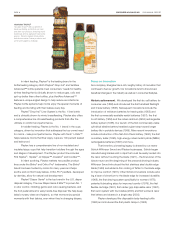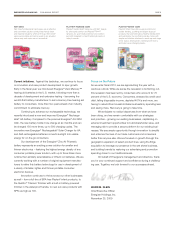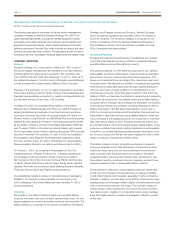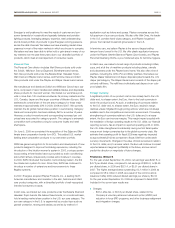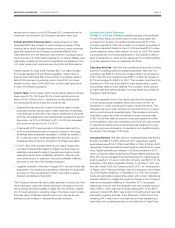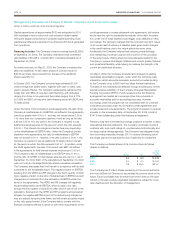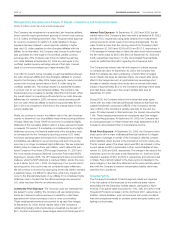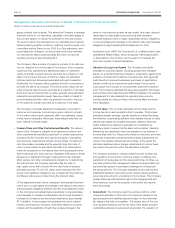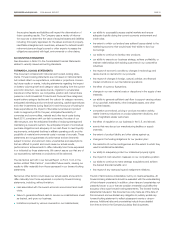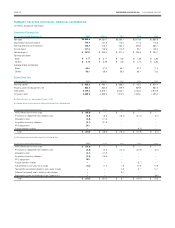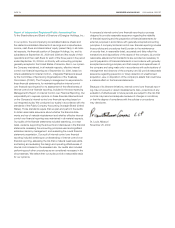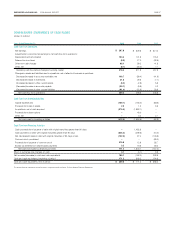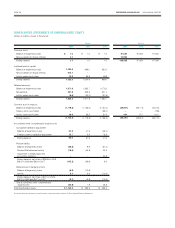Energizer 2009 Annual Report Download - page 20
Download and view the complete annual report
Please find page 20 of the 2009 Energizer annual report below. You can navigate through the pages in the report by either clicking on the pages listed below, or by using the keyword search tool below to find specific information within the annual report.
PAGE 18 ENERGIZER HOLDINGS INC. 2009 ANNUAL REPORT
Management’s Discussion and Analysis of Results of Operations and Financial Condition
(Dollars in millions, except per share and percentage data)
The Company has investments in a particular Latin American affiliate,
which currently require government approval to convert local currency
to U.S. dollars at official government rates. The government approval
for currency conversion to satisfy U.S. dollar liabilities to foreign
suppliers has been delayed in recent periods, resulting in higher
past due U.S. dollar payables to other Energizer affiliates with this
affiliate. As an alternative, the Company may choose to settle these
past purchases at a rate equal to the unofficial, parallel currency
exchange rate. If the Company was forced to settle the past due
U.S. dollar liabilities at September 30, 2009 at a rate equal to the
unofficial, parallel currency exchange rate as of that date, it would
result in a currency exchange loss of approximately $25.
In an effort to prevent further increases in past due liabilities between
this Latin American affiliate and other Energizer affiliates for product
imports, the Company, in May 2009, began paying for newly imported
product with invoices denominated in the U.S. dollar using the
unofficial, parallel rate. This change results in a substantial increase
in product cost for our Latin American affiliate. The Company has
implemented price increases to partially offset this cost impact. While
the overall impact on operating profit reported by our Latin American
affiliate was not material in 2009, we expect overall operating profit
from our Latin American affiliate to decline by approximately $15 to
$20 in 2010 as compared to 2009 due to this change based on the
current parallel rate.
Finally, we continue to monitor the inflation rate in this Latin American
country to determine if our local affiliate meets the accounting definition
of highly inflationary. Under GAAP, an economy is considered highly
inflationary if the cumulative inflation rate for a three year period meets
or exceeds 100 percent. If a subsidiary is considered to be in a highly
inflationary economy, the financial statements of the subsidiary must
be remeasured into the Company’s reporting currency (U.S. dollar)
and future exchange gains and losses from remeasurement of assets
and liabilities are reflected in current earnings until such time as the
economy is no longer considered highly inflationary. We use a blended
inflation index to measure three year inflation, which utilizes the pub-
lished Consumer Price Index (CPI) through December 31, 2007 and
the more recently developed National Consumer Price Index (NCPI)
beginning in January 2008. The CPI measurement was a more limited
measure, while the NCPI attempts to capture inflation across the coun-
try as a whole. As of July 1, 2009, the beginning of our current interim
reporting period, this country was not considered highly inflationary.
We will continue to monitor this issue going forward as inflation remains
a significant issue. It is difficult to determine, what if any, impact will
occur to the financial statements of our affiliate if it is considered highly
inflationary due to the fact that the official exchange rate versus the
U.S. dollar has been fixed for an extended period.
Commodity Price Exposure The Company uses raw materials that
are subject to price volatility. The Company will use hedging instru-
ments as it desires to reduce exposure to variability in cash flows
associated with future purchases of zinc or other commodities.
These hedging instruments are accounted for as cash flow hedges.
At September 30, 2009, the fair market value of the Company’s
outstanding hedging instruments was an unrealized pre-tax gain of
$6.1. Contract maturities for these hedges extend into fiscal year 2011.
Interest Rate Exposure At September 30, 2009 and 2008, the fair
market value of the Company’s fixed rate debt is estimated at $1,926.2
and $2,078.5, respectively, using yields obtained from independent
pricing sources for similar types of borrowing arrangements. The fair
value of debt is lower than the carrying value of the Company’s debt
at September 30, 2009 and 2008 by $3.8 and $151.5, respectively. A
10% decrease in interest rates on fixed-rate debt would have increased
the fair market value by $54.5 and $90.0 at September 30, 2009 and
2008, respectively. See Note 11 to the Consolidated Financial State-
ments for additional information regarding the Company’s debt.
The Company has interest rate risk with respect to interest expense
on variable rate debt. At September 30, 2009, the Company had
$628.6 of variable rate debt outstanding, of which $300 is hedged
via an interest rate swap as disclosed below. As a result, after giving
effect to the hedged amount, a hypothetical one percentage point
increase in variable interest rates would have an annual unfavorable
impact of approximately $3.3 on the Company’s earnings before taxes
and cash flows, based upon the current variable debt level at
September 30, 2009.
During 2009, the Company entered into interest rate swap agree-
ments with two major international financial institutions that fixed the
variable benchmark component (LIBOR) of the Company’s interest
rate on $300 of the Company’s variable rate debt for the next four
years. At today’s spread to this benchmark, the interest rate would be
1.9%. These hedging instruments are considered cash flow hedges
for accounting purposes. At September 30, 2009, the Company had
an unrecognized gain on these interest rate swap agreements of $3.4
included in Accumulated Other Comprehensive Income.
Stock Price Exposure At September 30, 2009, the Company held a
share option with a major multinational financial institution to mitigate
the impact of changes in certain of the Company’s deferred compen-
sation liabilities, which are tied to the Company’s common stock price.
The fair market value of the share option was $2.0 as included in other
current assets and $2.4 as included in other current liabilities at Sep-
tember 30, 2009 and 2008, respectively. The change in fair value of the
total share option for the years ended September 30, 2009 and 2008
resulted in expense of $3.0 and $16.2, respectively, and was recorded
in SG&A. Period activity related to the share option is classified in the
same category in the cash flow statement as the period activity associ-
ated with the Company’s deferred compensation liability, which was
cash flow from operations.
Seasonal Factors
The Company’s Household Products segment results are impacted
in the first quarter of the fiscal year by the additional sales volume
associated with the December holiday season, particularly in North
America. First quarter sales accounted for 31%, 32% and 30% of total
Household Products net sales in 2009, 2008 and 2007, respectively. In
addition, natural disasters, such as hurricanes, can create conditions
that drive exceptional needs for portable power and spike battery and
lighting products sales.


